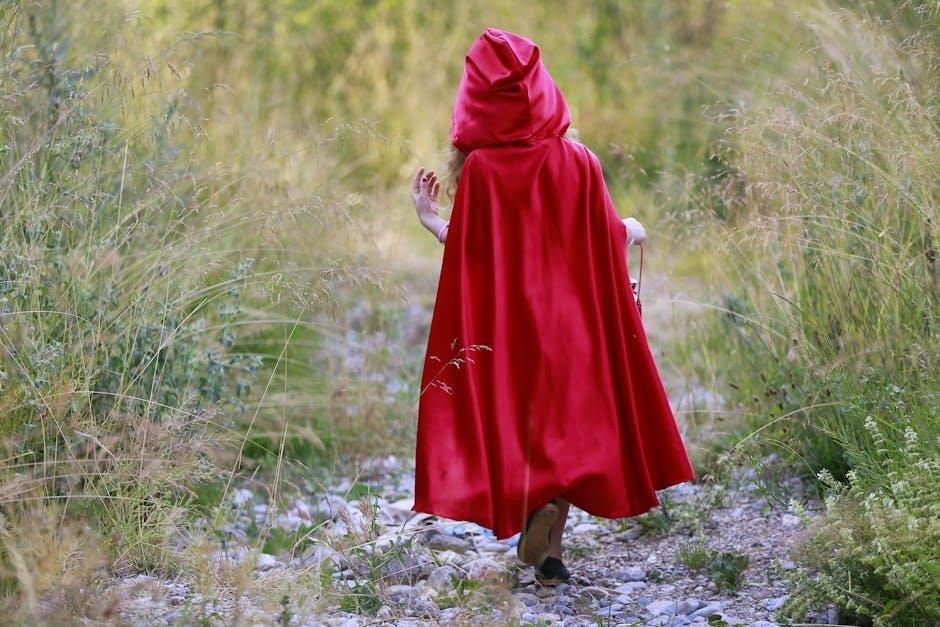Overview of Little Red Riding Hood
Little Red Riding Hood is a classic fairy tale with roots in European folk tales. Popularized by Charles Perrault and the Brothers Grimm‚ the story features a girl‚ a wolf‚ and a cautionary message. The tale’s enduring appeal lies in its adaptability.
The Classic Fairy Tale’s Enduring Appeal
The enduring appeal of Little Red Riding Hood stems from its simple yet profound themes that resonate across generations. The story explores universal concepts such as innocence‚ danger‚ and the importance of heeding warnings. Its adaptability allows for diverse interpretations‚ from cautionary tales about stranger danger to symbolic explorations of societal norms and sexual awakening. The tale’s ability to be reimagined in countless forms‚ including books‚ films‚ and other media‚ ensures its continued relevance. The narrative’s power lies in its capacity to tap into primal fears and desires‚ making it a timeless classic.
Origins and Early Versions
The story’s origins trace back to pre-17th century European folk tales. Versions like “The False Grandmother” existed before Perrault and Grimm. These oral traditions showcase the tale’s evolution before written forms.
Pre-17th Century European Folk Tales
Before Charles Perrault’s and the Brothers Grimm’s published versions‚ the story of Little Red Riding Hood existed in various oral forms across Europe. These early tales‚ predating the 17th century‚ often featured darker themes and more violent outcomes than the versions we know today. “La Finta Nonna” (The False Grandmother) is one such example‚ involving trickery and cannibalism. These stories served as cautionary tales‚ highlighting the dangers of the woods and the importance of heeding warnings. The characters and plot elements evolved over time‚ shaped by cultural values and societal anxieties‚ before solidifying into the familiar narrative.
Charles Perrault’s Version
Charles Perrault published “Little Red Riding Hood” in 1697 in Histoires ou Contes du temps passé. His version includes a “moralité‚” emphasizing the dangers faced by young women from charming strangers. This version lacks a rescue‚ ending with the wolf’s victory.
Moralités and Regulation of Sexuality
Perrault’s version of “Little Red Riding Hood” consciously reinforces the regulation of sexuality. The story serves as a cautionary tale‚ warning young women about the dangers of straying from the prescribed path and engaging with unfamiliar men. The “moralité” explicitly states that children‚ especially attractive young girls‚ should not trust strangers‚ as they may be deceived by charming words. This interpretation reflects 17th-century French social norms‚ where female virtue and obedience were highly valued. The tale highlights the vulnerability of young women and the potential consequences of disobedience‚ reinforcing societal expectations and control over female sexuality.
The Brothers Grimm’s Version
The Brothers Grimm published their version‚ “Little Red-Cap‚” in 1812. This version differs from Perrault’s. The narrative shifts‚ providing a more hopeful ending with the intervention of a huntsman‚ altering the story’s interpretation.
Little Red-Cap and the Shift in Interpretation
The Brothers Grimm’s “Little Red-Cap” introduces a significant shift in the narrative. Unlike Perrault’s version‚ which ends with the wolf’s victory and a stark moral‚ the Grimm’s tale offers a more redemptive conclusion. A huntsman appears‚ rescuing Little Red-Cap and her grandmother from the wolf’s belly.
This intervention marks a change in the story’s interpretation‚ moving away from a simple warning about strangers to a narrative of triumph over evil. The huntsman’s role provides a sense of justice and protection‚ making the story more palatable for younger audiences. The shift highlights the evolving nature of fairy tales and their adaptation to reflect changing cultural values.

Variations in the Story
The tale of Little Red Riding Hood has many variations. Differences exist in the endings where she is either eaten‚ or saved by a woodsman. The characters and their roles also change across versions.
Differences in Endings and Characters
Across various tellings of Little Red Riding Hood‚ the endings diverge significantly. Some versions conclude with the wolf devouring both Little Red Riding Hood and her grandmother‚ a grim fate emphasizing the story’s darker origins. Other renditions introduce a huntsman or woodcutter who rescues them‚ often by killing the wolf and cutting them from its belly.
The characters themselves also vary; while the core figures of Little Red Riding Hood‚ the wolf‚ and the grandmother remain constant‚ their individual traits and motivations can shift. Some adaptations add or modify supporting characters‚ altering the dynamics and moral lessons conveyed.

Interpretations and Morals
Little Red Riding Hood offers several interpretations‚ notably the “stranger danger” moral. The story also explores themes of obedience‚ deception‚ and vulnerability. Some analyses even delve into darker‚ more complex psychological interpretations.
Stranger Danger and Other Underlying Themes
The prevalent “stranger danger” interpretation of Little Red Riding Hood serves as a cautionary tale for children. It emphasizes the importance of heeding parental warnings and avoiding interactions with unfamiliar individuals. However‚ the story’s layers extend beyond this simple moral. Underlying themes involve female vulnerability‚ the dangers lurking beneath a seemingly safe surface‚ and the loss of innocence. The wolf embodies deception and predatory behavior‚ while the forest symbolizes a realm of uncertainty and potential threats. Some interpretations even explore themes of sexuality and societal regulation‚ particularly in Perrault’s version‚ which included overt moral lessons.

Modern Adaptations
Little Red Riding Hood’s core narrative has been widely adapted into films‚ literature‚ and other media. These modern versions often reimagine the story with darker twists‚ romantic subplots‚ or supernatural elements‚ appealing to a diverse audience.
Film‚ Literature‚ and Other Media
The tale of Little Red Riding Hood continues to inspire diverse adaptations across various media. Catherine Hardwicke’s “Red Riding Hood” (2011) presents a supernatural romance‚ while other films add werewolf mysteries and darker suspense. Literary adaptations range from faithful retellings to parodies and reinterpretations. These modern versions explore themes beyond the traditional narrative‚ often incorporating elements of horror‚ thriller‚ or fantasy. The story’s core elements – the innocent girl‚ the deceptive wolf‚ and the red cloak – remain recognizable‚ but are creatively reimagined to resonate with contemporary audiences. The story’s adaptability ensures its continued presence in popular culture.
The Red Hood/Cap Symbolism
The red hood or cap is a central symbol. It represents innocence‚ vulnerability‚ or even defiance‚ depending on the interpretation. Its cultural impact is significant‚ often associated with childhood and danger.
Significance and Cultural Impact
The red hood’s symbolism is deeply embedded in culture‚ often representing a transition from childhood innocence to the dangers of the adult world. The color red can signify passion‚ danger‚ or even defiance‚ adding layers to the character’s portrayal. In some interpretations‚ the hood represents a sign of prosperity or a gift of love‚ highlighting different facets of the tale. The story’s cultural impact extends to fashion‚ art‚ and literature‚ where the red hood serves as an enduring motif. Its significance lies in its ability to evoke a range of emotions and interpretations across diverse audiences.

Grimm’s Fairy Tales PDF Availability
Digital versions of Grimm’s Fairy Tales‚ including “Little Red-Cap‚” are widely accessible online. Many websites offer free PDF downloads‚ providing convenient access to these classic stories for reading and research purposes.
Finding and Accessing Digital Versions
Locating a PDF of Grimm’s Fairy Tales‚ which includes “Little Red-Cap‚” is relatively straightforward. Numerous online resources offer downloadable versions. Project Gutenberg is a reliable source for free‚ legal ebooks‚ including collections of Grimm’s tales. Archive.org also hosts digitized versions of older books‚ potentially including early editions of the fairy tales.
Additionally‚ many websites dedicated to fairy tales and folklore provide PDFs for educational or personal use. When downloading‚ ensure the source is reputable to avoid malware or copyright infringement. Always check the terms of use before sharing or distributing any downloaded files.
The Story’s Historical Context
Little Red Riding Hood reflects social anxieties and cultural norms. The tale evolved through oral tradition‚ influenced by societal concerns about safety‚ obedience‚ and the dangers lurking beyond familiar boundaries within the historical landscape.
Social and Cultural Influences on the Narrative
The narrative of Little Red Riding Hood is deeply entwined with the social and cultural contexts of its time. Earlier versions‚ predating Perrault‚ emerged from oral traditions reflecting peasant life and potential dangers of the forest. Perrault’s version‚ written for a courtly audience‚ served as a cautionary tale with moral implications‚ regulating sexuality and obedience.
The Brothers Grimm further adapted the story‚ emphasizing different aspects and reinforcing societal values. The tale’s evolution showcases how cultural anxieties‚ moral teachings‚ and social expectations shape storytelling‚ resulting in varied interpretations across different eras and communities‚ influencing the narrative.